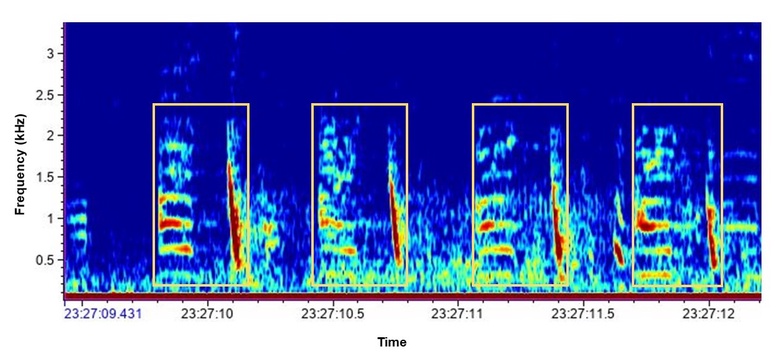What is Artificial Intelligence?
AI is a branch of computer science which develops algorithms that enable computers to perform complex tasks and learn from experience, as if they were intelligent beings. Although we are often unaware of it, AI is part of our daily life: it corrects our texts, filters spam emails, recognises the songs we are listening to…
Research is also benefiting from advances in AI technologies. AI algorithms can automate tasks to speed them up and reduce human effort. The best part is that AI is perfect for working on repetitive tasks because it doesn’t get tired or bored. For instance, AI can count the number of zebras in a photograph, or even identify individual manta rays from their unique markings. Meanwhile, biologists can invest more of their time answering key research questions that can improve our knowledge and help conserve and manage populations.
Why did we need AI?
Studying marine organisms is challenging, particularly for wide-ranging species that surface quickly and forage on prey you might never see. Thankfully, marine mammals are often very communicative underwater, and we can use vocalizations to study their presence and behaviour. For instance, the bottlenose dolphins we study make a specific sound when foraging for salmon. These bray calls are very distinctive donkey-like vocalizations (see figure below and listen to the audio clip here). However, identifying these underwater sounds is not easy or quick. For years we’ve relied on researchers spending days manually checking underwater recordings, searching for bray calls to identify when they were produced.

How does DOLPHIN-SPOT work?
As part of our PhDs, we’ve studied interactions between dolphins and salmon in the Moray Firth (North East Scotland). Our aim was to study environmental factors affecting dolphin-salmon interactions in two foraging hotspots. After collecting our acoustic data, we faced the challenge of processing months of sound recordings, which could be a time-consuming process. Luckily, at the latest World Marine Mammal conference, Rachael Xi Cheng (Osnabrük University) came to our rescue. Rachel and her colleagues have developed an AI detector for killer whale calls called ORCA-SPOT. As killer whale vocalizations are similar to dolphin calls, we were able to re-train the same AI algorithm to recognise dolphin brays, and so DOLPHIN-SPOT was born. In simple terms, these AI detectors work like the app Shazam from our mobile phones, they “listen” to the audio recordings and tell us when they detect a vocalisation. While the shazam app recognises songs, these AI algorithms recognise specific orca/dolphin vocalizations. After many months of work, our DOLPHIN-SPOT AI model is processing data faster than we could have ever imagined. For example, to manually process 1 hour of audio-recordings, we would have taken approximately 1 hour to extract dolphin vocalizations, whilst the automatic detector does the work for us in under a minute. DOLPHIN-SPOT has made it possible to process months of data collected in 2020 in just a few days, which is allowing us to investigate important conservations questions faster - stay tuned for some exciting results coming out soon.
For more details on DOLPHIN-SPOT have a look at our 5 min presentation here and if you want even more details here you’ll find a presentation we gave at the SBS informal seminar in May 2021 (~ 1 h approx.).
What made it possible?
As biologists, with no prior knowledge of AI, creating DOLPHIN-SPOT has been a particularly challenging journey. However, we made it (!) and we wanted to share some lessons we learned along the way:
- First and foremost, the importance of collaborative and interdisciplinary work. This project has been a great example of the phrase “teamwork makes the dream work”. We have collaborated with computer scientists to implement a cutting-edge methodology, enabling us to test hypotheses that were impossible to investigate a few months ago. In an era where AI can provide scientists with new tools, building partnerships with computer scientists is vital. We know the knowledge gaps in our fields and the tools we need to answer them, while they have the computer skills to create them - it’s the perfect match. If you have a repetitive manual task, there is probably a computer scientist out there who can automate it for you. You just need to find them and provide them with good quality data for training their algorithm.
- The realisation that we didn’t need to understand everything, just enough, to make DOLPHIN-SPOT work. ORCA-SPOT was originally written on Python, a coding language which was totally alien to us. Although we have learned lots during our journey, we don’t understand every line of code and there’s no need to. As a team, we share a knowledge of the process, and we trust each other’s expertise for the details.
- Finally, open-source resources move science forward. We were only able to create an automatic detector of bottlenose dolphin calls because the developers of ORCA-SPOT made all the code available on GitHub (thanks Bergler et al.!). We share the philosophy that science should be reproducible, and publicly available. Therefore, we’ll also share all the protocols and code that we created during the development of DOLPHIN-SPOT and, this way, other marine mammal researchers won’t face the same systematic challenges we did. Moreover, our automatic detector will be available in PAMGuard, an open-source software for passive acoustic monitoring. Stay tuned for updates on this @CromartyLH, @virgiIorio and @OihaneFdez.
How can AI help you?
Whatever the field you work in, AI could potentially provide a huge benefit to your work, as it did to ours. So be creative and think outside the box, if we made it, you definitely can do it too.


